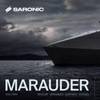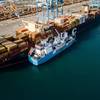Wind Farm Positioned with Ashtech ProFlex
Five Ashtech ProFlex 500 GNSS receivers are helping guide the operations of the self-propelled jack-up vessel Bard Wind Lift I, the first construction vessel specially designed for installing offshore wind turbines, to build the first commercial wind farm in the German North Sea. The Ashtech GNSS receivers are used for every maneuver of Wind Lift I, including precisely positioning the vessel, assisting it to accurately jack itself up from the seabed on 233 ft long legs, and installing the foundation piles for the wind turbines.
EIVA, the Danish provider of system solutions and services for marine survey, provided the positioning solution for Bard, the German designer, builder and operator of the offshore wind farm. EIVA created and installed the special positioning system employing five Ashtech ProFlex 500 GNSS receivers integrated to a survey grade gyrocompass and a motion sensor. Two of the Ashtech receivers are located on two of the legs of the Wind Lift 1. Another antenna is located on the 500-tonne crane boom at the stern of the vessel, and a fourth ProFlex 500 is on the supply barge lying alongside to assist the crane’s operator during lifting operations. Lasers measure the distances between antennas and distance to the deck during pile driving. All sensors are interfaced to EIVA’s software NaviPac to manage placement of the piles. A fifth ProFlex 500, placed on a separate platform in the BARD Offshore 1 operational area, acts as a reference station to provide the required centimeter-level accuracy.
The 500-ton crane on the stern of Wind Lift I hydraulically grips and lifts the foundation pipes and positions in an exact position on the bed of the North Sea. Then the vessel’s pile hammer drives the support pipes into the seabed. Once the supporting crosspiece, which weighs around 450 tons, has been mounted, the tower, nacelle and finally the rotor, 400 ft in diameter, are installed. The EVIA pile positioning solution ensures that the foundations are placed efficiently and vertically despite their enormous size and difficult sea conditions.
www.ashtech.com






